How we manage the lineups at King Edward Station
How we manage the lineups at King Edward Station
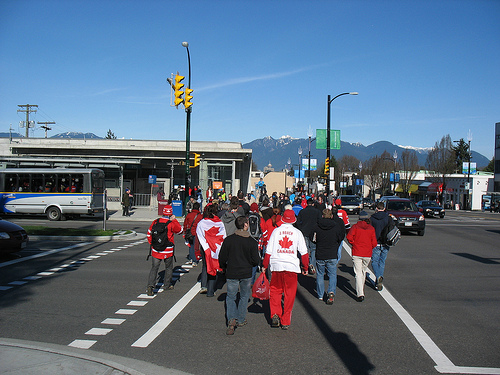
Here’s another lineup story about King Edward Station, which is considered the toughest SkyTrain station for managing lineups during the Games. Oooh!
What’s so difficult about King Edward Station? The main challenge is that there is not very much sidewalk space around the station. That means you can’t usher crowds into long lineups sprawling over a great amount of space, like you can at Waterfront Station.
This is an issue because the curling venue holds 5,600 people, meaning thousands will emerge after their event ends, looking to get onto the Canada Line, and there’s not a lot of space to put them (and we don’t want them spilling into the street!).
But: we have a plan! And it seems to be working thus far. Here is the diagram of the queue management flow.
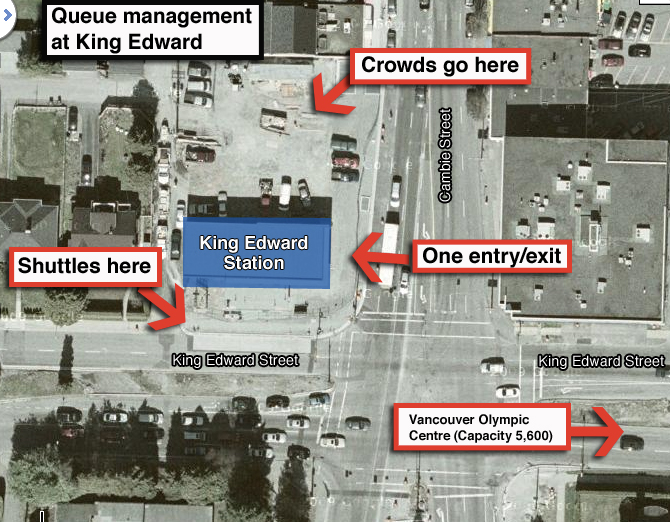
That’s right: passengers get lined up in the parking lot adjacent to King Edward. Community shuttles are taking those with mobility issues to the curling venue, so the space on the south side of the station is reserved for them and isn’t really available for lineups.
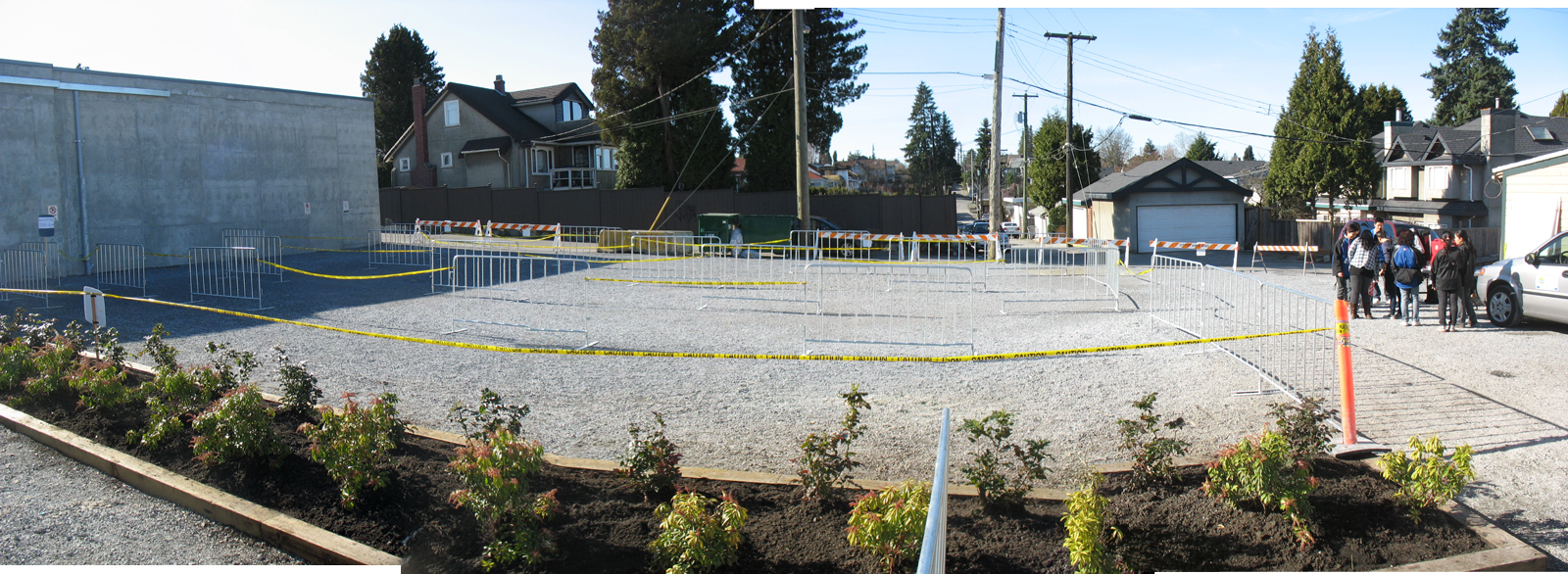
Fencing and security tape maneuver the line into a zig zag formation, and so we can maximize the number of people waiting for the trains. And hosts direct incoming crowds to enter the parking lot to line up for the Canada Line after an event.
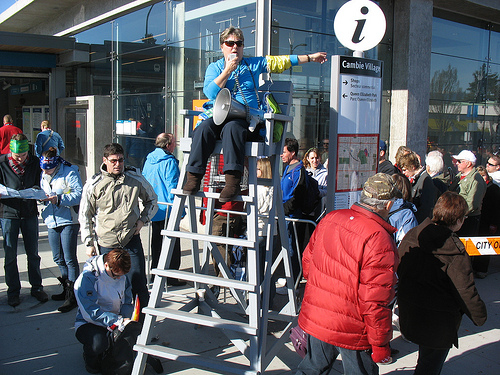
At King Edward, we do again have a transit “lifeguard,” who directs the crowd from atop a high perch.
Here is the queue management strategy starting into action after the first curling event let out at noon on Thursday, February 18. Watch the video clip above and you’ll hear a queue volunteer asking people to stay out of the Olympic lane (they’re for cars, not spectators!) and ushering them toward the parking lot to begin lining up for the Canada Line. (At this point, it’s early, and people are able to flow right into the station.)
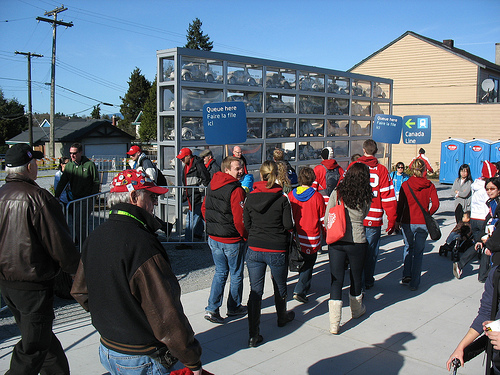
A few volunteers hold up signs saying “Queue here” to show people where to line up. Eventually they headed further into the parking lot area as more people arrived.
In the clip above, the front of the queue isn’t flowing anymore, and lineups are starting to accumulate in the parking lot area adjacent to the station. The volunteer on the megaphone is nice and cheery though!
And here’s another view of the lineup in the parking lot. The Salvation Army volunteers handing out hot chocolate were a welcome treat for many.
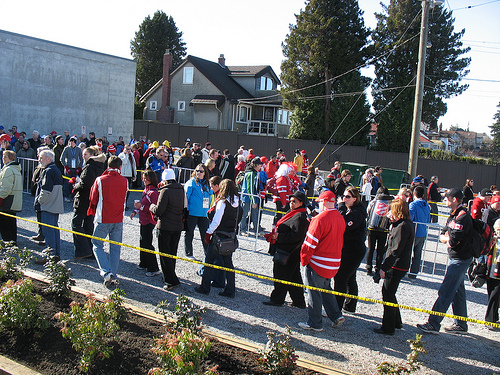
Now a few spectators would emerge from the event, look at the lineup, and get completely scared. However, it is deceptively long — to be honest, for the crowd I just filmed and photographed here, the whole thing was cleared in roughly 20 minutes.
Canada Line attendants helped pace the flow of riders, and every five minutes or so, another group of people in the lineup would get loaded onto trains downstairs. (Side note: almost everyone was headed to Waterfront. The few who were headed to Richmond were asked to zip to the front of the queue and get on southbound trains ahead of the others.)
And yes, it was a lighter crowd for the morning event, but it still shows that the queues are really not that bad — they just might look it!
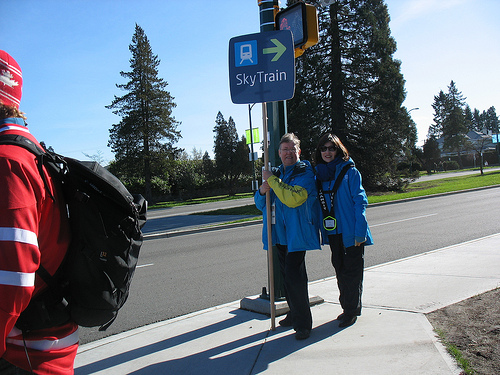
A few more items. King Edward Station is at one corner of an intersection, and transit hosts stood at the other three corners of the intersection as well, giving customers advice and directions. Queue management volunteers also stood there with signage pointing the way to King Edward Station.
Traffic cops also play a role, standing on the corner of the station and ensuring traffic doesn’t sideswipe any spectators. I didn’t manage to get any photos of the police though: sorry!
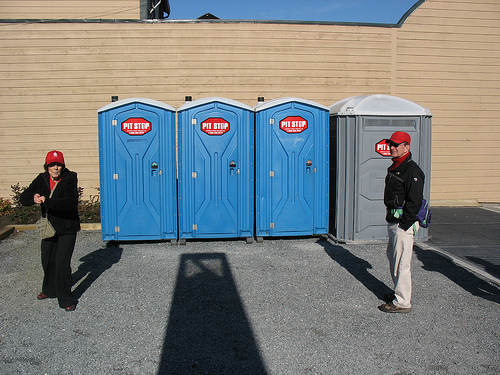
There are port-a-potties by the station, for those experiencing the call of nature!
And here is a video of transit host Suzanne directing people to the curling venue. Three curling events are back-to-back-to-back most days, meaning while one event is letting out, spectators are just arriving to get through security for the next event. It’s important to keep the flow going!






I got off the 25 bus at King Edward Stn yesterday at around 5.15, the staff were certainly cheerful and patient, the travellers were behaving themselves too. However, I saw the crowds and freaked out, since it was a very pleasant day I decided to walk! Just took me half an hour and I would have probably waited in that line for that long than that anyhow.
I just got back from a curling event, actually, and my friends and I took the Canada Line downtown afterwards. What you describe above is working *super well*. We were middle to back of the pack coming out of a (sold-out, full) curling session and, from the time we got to the station, we were on a train in under 10 minutes.
We’ve been taking transit everywhere, like we would even if it weren’t Olympics, and have all been impressed with how well it’s working.
Ha ha, the Transit Lifeguard looks good, I hope there’s no danger of them getting knocked over.
Managing how spectators approach the station can help. Can you get them to cross Cambie Street opposite the queuing-(car)-park rather than at the intersection?
If the station and venue were arranged closer together I would get them directed out of the venue in the wrong direction, and take a longer route round a block to the station. You’d get a few locals knowing better, but they’d just have to walk back to get to the end of the queue. The real experts just enjoy the sunshine and walk to the next station or a bus stop.
Oh, and queues are a great place to start some friendly cheering that you’ve heard about. Can-a-da, Can-a-da!…
Gregory:
You’ve actually hit the strategy for getting people to/from the venue. Spectators have to walk along King Edward Street to get to the venue. Then they take a route down Cambie Street to get back to the station once the event is over.
As to your first question, it actually seemed pretty tough in practice to convince people to cross at a specified crosswalk. When I was there, one of the transit hosts urged everyone not to cross when a particular light changed, but everyone just crossed anyway!
I’m sure if the police wrote some tickets, people would smarten up.
Just a side note. The “transit attendants” that were handling the queue were actually VANOC volunteers and their supervisors.
Yes, that’s right. While TransLink managed the queue management process, volunteers from VANOC made it all happen. At some stations, volunteers from other organizations like UBC and SFU were involved too.
[…] adjacent parking lot, to see how it looked during the Paralympics. It was empty when we used it for lineups during the Olympics — now it’s back to business as […]